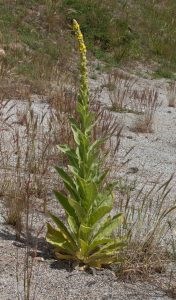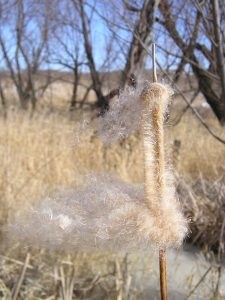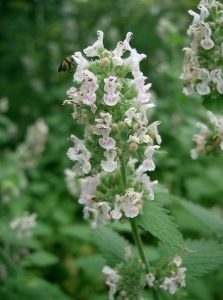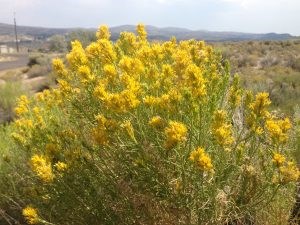This content was originally published by the Longmont Observer and is licensed under a Creative Commons license.
Even though Halloween is over, I thought I’d write this article anyway as I’ve been wanting to do something on the traditional use of plants for a while now. Please remember that much of this is folklore and you should not attempt to use these plants for medicinal purposes without professional assistance.

The first plant that can be seen readily in the open areas around Longmont is great mullein, which I will describe, as most may not be familiar with it. The leaves are green and are covered in thick hairs on both sides. Leaves first appear as a rosette on the ground, with a single stalk eventually arising from the rosette. This stalk does not appear usually until the plant is two years old. Broad leaves are arranged opposite each other on the stalk. The smaller leaves above direct the water to the larger leaves below which in turn direct water toward the roots. Great mullein has yellow flowers arranged around the tip of the stalk. The stalk is also covered in dense hairs, giving the plant a greyish-green appearance. The stalk can grow to be four to five feet in height with flowers covering a foot of it. The hairs on the plant act as a defense against insects that would feed on the plant as well as acting as an irritant to the mucous membranes of herbivores that try to eat them. People making tea from the plant need to be careful to strain the tea to remove these hairs or they will cause itching in the mouth.
One of the other names for this plant is Candlewick Plant because, when dried, the stem and hairs make excellent tinder and the down was used for lamp wicks. Some superstitious people believed that witches frequently used this plant for lamps and candles in their incantations. Stalks dipped in suet were used as torches at funerals. The leaves and flowers were used medicinally, particularly to treat diseases of the lungs and coughs. It has also been used as a poultice to treat hemorrhoids. Tea made from the plant leaves and flowers has been used to treat diarrhea, and was made with milk when bleeding was present. Flowers were used to make distilled water that was used to treat burns. Mullein oil has been used to treat earaches and is considered to be a good defense against germs. Migraines and headaches have also been treated using an alcoholic tincture of the plant.

The second plant is our area that has been used both medicinally and for survival purposes is the cattail. This plant needs no introduction as it is prominent in marshy areas. Cattails have a brown seed head, whereas several look-a-like plants that are poisonous do not. Cattails have been used as food plants for a very long time. In the spring, the roots can be dug up and the shoots coming off of them can be peeled an eaten. The shoots can be peeled and eaten until they are about two to three feet above water and are also known as Cossack asparagus because Russians are fond of it. In late spring and early summer, the male and female portions of the plant will begin to emerge. They are easy to find when you are close to the plant. By peeling back the cattail leaves like you would if you were shucking corn, you will find the female bloom spikes and the male pollen spike. The female bloom spike will eventually turn into the brown seed head and the male pollen spike can be seen as a small twig on top of the seed head. The female and male spikes can be boiled and eaten like corn on the cob, but may also be eaten raw.
Poultices made from the bruised roots were applied to cuts, burns, stings, and bruises. People would burn the leaves and use them as an antiseptic for wounds or to stop bleeding. Near the base of the plant, there is a small drop of honey-like material that has also been used as an antiseptic for wounds and to treat toothaches. The seed heads and dried leaves make good tinder and the fluffy material inside the seed heads can be used as insulation or to stuff pillows and bedding. One traditional use of cattails was to use the leaves to weave seats and chair backs. They can also be used to weave baskets, mats, or hats. Dried seed heads dipped in animal fat can be used as torches.

Although we often plant catnip or catmint in our gardens, it can readily be found growing wild around Longmont. The French use the leaves and young shoots as culinary herbs in their cooking. Catnip is well known for its medicinal properties. The flowering portions of the plants are the parts used most often in herbal concoctions. It has been used to relieve flatulence and was also thought to stimulate menstrual flow. Catnip is thought to increase perspiration and cause drowsiness and therefore was often used to treat colds and fevers. It is also thought to calm the nerves. Catnip was known to be used to treat hysteria and nightmares. Poultices applied to injured body parts was thought to reduce swelling. Using a mixture of catnip to wash the hair was supposed to relieve dandruff.

The last plant I am going to cover is rabbitbrush, also known as rubber rabbitbrush. Rabbitbrush is an evergreen plant that grown in sandy or clay soils and flowers in September and October. An extraction of the twigs has been used to treat toothaches, coughs, and chest pains. A tea made from the flowers was used to treat colds, and tea made from the leaves and stems was also used to treat colds as well as diarrhea. The plant shows bactericidal activity and a wash made from the plant was used to treat sores. At one point it was used to help treat smallpox. Using a very small amount of an extract, blood pressure was lowered in rabbits. Part of the root can be used for chewing like gum. The plant is also a source of latex. Rabbitbrush leaves have been used for towels after childbirth or for other sanitary purposes. Dye can be obtained from both the bark and the flowers. Green dye is obtained from the bark and yellow dye from the flowers. When the plant flowers turn to fruit, they contain a cottony material that can be used to stuff pillows and blankets. The plant itself is thought to repel insects.
The next time you are out exploring Longmont’s open spaces, look for some of these plants. Often, they are not far off the trail. Remember how our ancestors used these plants for all types of things and wonder whether they may hold the secret to some new cure.


